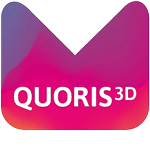Every clinician has lived it: the denture case that seemed straightforward but quickly turned into a series of frustrations. Records go missing, the bite registration doesn’t quite add up, impressions need retaking, and the lab emails back with questions that eat into your lunch break. By the time the patient is fitted, what should have been a routine case has stretched into multiple appointments and hours of lost time.
It is precisely these inefficiencies that digital dentistry is beginning to resolve. In a recent webinar hosted by Quoris3D, Sales Director Ian Creighton and Head of Prosthetics Sarah Faulkner explored how a more streamlined, digitally supported approach can transform the way clinicians manage denture cases — not by discarding analogue methods, but by creating smarter workflows that combine the best of both worlds.
From Frustration to Flow
“Too often, denture cases are delayed not because of complexity, but because the right information wasn’t captured at the right time,” Faulkner explained to her audience. “Clear workflows mean fewer retakes, fewer emails, and more predictable results.”
Predictability was a recurring theme. By structuring each stage of treatment — whether starting with a scan or a traditional impression — the process becomes easier to follow, easier to plan, and easier to deliver. Clinicians can focus on the patient in front of them rather than firefighting errors or chasing lost details.
Digital Without Exclusion
One of the myths Faulkner and Creighton were keen to challenge is that digital dentures require a fully digital practice. In reality, they emphasised, analogue and digital can work seamlessly together.
“You don’t have to be all-in on digital to benefit,” Creighton said. “Clinicians can send either scans or impressions, and both can be integrated into a digital workflow. That flexibility is crucial because it lets practices adopt new ways of working at their own pace.”
This hybrid model is particularly powerful in immediate cases. With the right records, a Lucitone denture can often be designed, manufactured and fitted in just two appointments — a huge saving of time for both clinician and patient, and a major reassurance for those undergoing extractions.
Materials That Match the Moment
The discussion also highlighted how far denture materials have come. Printed resins such as Lucitone now offer a balance of strength, impact resistance and wear properties that would once have seemed impossible. Milled PMMA bases continue to set the standard for accuracy and durability, while traditional high-impact acrylic remains a dependable option when crafted with care.
“The point isn’t to say one material is better than another,” Faulkner reminded attendees. “It’s about having options. Printed Lucitone is excellent for immediates; milled PMMA gives unmatched precision; and hand-finished acrylic still has its place. The clinician can choose the right solution for the right patient.”
That flexibility extends to teeth. The Lucitone Digital IPN range provides wear resistance on a par with conventional PMMA, while Enigmalife+ teeth have drawn widespread praise for their natural appearance. The result is not compromise but choice, allowing prosthetics to be tailored to each case.
Beyond the Appliance
Perhaps the most striking point was that dentures should no longer be viewed as a product alone, but as a process. A prosthesis is only as good as the workflow that created it.
Clear digital pathways, supported by structured case submission tools, cut down on ambiguity and bring consistency to what has traditionally been one of the least predictable areas of restorative dentistry. For the clinician, that means less wasted chair time; for the patient, a smoother journey and a better outcome.
Building Confidence Through Education
Faulkner, whose clinical specialism is overdentures, also stressed the importance of ongoing education. Bar design, attachment choice and space analysis are not topics many clinicians feel comfortable with, yet they can have a profound impact on long-term success.
“These are the kinds of details colleagues ask me about all the time,” she said. “Study clubs and webinars are a way to share that knowledge — not just the ‘how’, but the ‘why’. When clinicians understand the rationale behind design choices, they can approach their cases with far more confidence.”
Towards Smarter Dentistry
The impression left by the session was not of digital dentistry replacing the analogue, but of the two working together in harmony. Digitisation provides the clarity, accuracy and efficiency that modern dentistry demands; analogue techniques supply the artistry and adaptability that no technology can replace.
For clinicians, the lesson is simple: denture provision need not be the unpredictable, time-consuming headache it once was. With the right workflows and laboratory support, it can become a process that is smoother, more predictable and ultimately more rewarding.
As Faulkner concluded:
“When we talk about working smarter, it’s not about shortcuts. It’s about confidence — confidence that each stage is clear, each case is supported, and that the outcome is something both clinician and patient can be proud of.”




